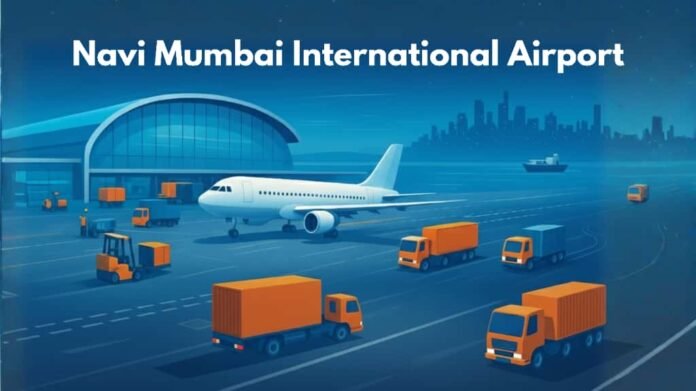India’s logistics landscape is set for a major transformation with the launch of Navi Mumbai International Airport (NMIA) — a project that promises to redefine how goods move across western India and beyond. Beyond being just another passenger hub, NMIA is poised to become a strategic logistics and cargo powerhouse that can unlock new efficiencies across the supply chain.
Strategic Location: Seamless Sea–Air Connectivity
NMIA’s biggest strength lies in its location near the Jawaharlal Nehru Port Trust (JNPT) — India’s largest container port.
This proximity creates a rare sea–air multimodal advantage, enabling exporters and importers to switch cargo modes faster, cut dwell times, and reduce logistics costs.
For time-sensitive shipments like pharmaceuticals, electronics, and perishables, this integration can cut transit times by up to 30–40%, improving delivery reliability.
Boost to Air Cargo Infrastructure
In its first phase, NMIA will handle 0.5 million metric tonnes of air cargo annually — eventually scaling up to over 3 million tonnes.
The airport features:
- Dedicated cargo terminals
- Automated cargo handling systems
- Cold chain facilities for temperature-controlled goods
- Paperless and cashless clearance processes
This will ease the cargo pressure on Mumbai’s existing airport, which is already running at maximum capacity.
Multimodal Connectivity for Faster Movement
The airport is designed as India’s first truly multimodal aviation hub, connected through:
- Mumbai Trans Harbour Link (MTHL)
- Sion–Panvel Expressway & NH-4B
- Metro & Suburban Rail Network
- Water transport links
Such connectivity ensures faster first-mile and last-mile logistics, reducing congestion and improving turnaround times for trucks and containers.
Enabler for E-Commerce and Express Logistics
With the rise of quick commerce and cross-border e-commerce, NMIA will serve as a fulfilment gateway for western and southern India.
Companies can establish distribution centres and bonded warehouses near the airport to serve Mumbai, Pune, and Gujarat markets efficiently.
The airport’s proximity to industrial belts like Taloja, Bhiwandi, and Panvel further strengthens its role in the regional e-commerce ecosystem.
Pharma & Cold Chain Advantage
Maharashtra is home to major pharmaceutical and biotech clusters, and NMIA’s temperature-controlled cargo zones will help maintain product integrity throughout the supply chain.
Dedicated cold storage zones, digital documentation, and faster customs clearance make it ideal for:
- Vaccine exports
- Life-saving drug shipments
- Perishable food exports
This will boost India’s credibility as a global pharma export hub.
Warehousing & Logistics Park Development
The airport’s development is expected to trigger a real-estate and warehousing boom in nearby areas such as Ulwe, Panvel, and Taloja.
Several logistics parks, truck terminals, and cold chain hubs are already being planned.
These will attract:
- Freight forwarders
- 3PL/4PL service providers
- Custom brokers
- Export-import companies
Together, this will create an integrated aerotropolis — a city built around logistics, trade, and transport.
Employment and Skill Growth
The supply chain ecosystem around NMIA will create thousands of new jobs — in cargo handling, customs, transportation, warehouse operations, and logistics technology.
This will boost regional employment and foster skill development in modern supply chain practices.
Challenges Ahead
While the outlook is strong, the ecosystem will need to manage:
- Efficient coordination between port, airport, and customs
- Digital integration across supply chain nodes
- Infrastructure readiness and congestion control
- Competitive ground handling tariffs
Addressing these will determine how effectively NMIA can deliver on its logistics potential.
Conclusion: Transforming India’s Cargo Future
Navi Mumbai International Airport isn’t just another aviation project — it’s the missing link in India’s multimodal logistics network.
By connecting sea, air, road, and rail seamlessly, NMIA can position India as a global cargo hub, streamline export-import trade, and support industries that depend on speed, reliability, and cost efficiency.
For India’s supply chain, the sky is no longer the limit — it’s just the starting point.



